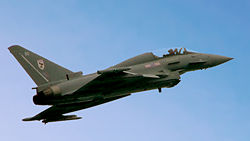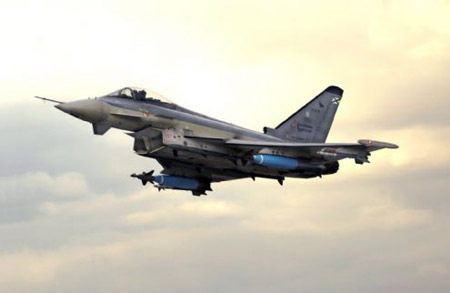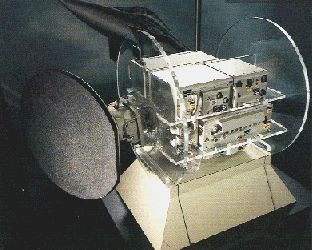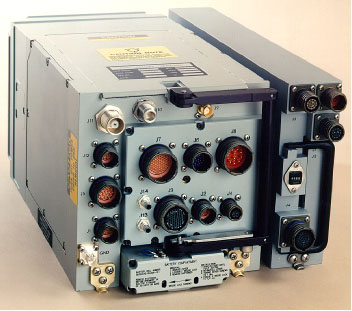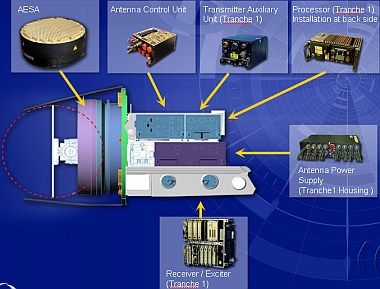Trabajo desde 1999 en INDRA SISTEMAS S.A.
en labores de ingeniería de software de sistemas embarcados en tiempo real para el Eurofighter Typhoon, avión de caza europeo.
El Typhoon es un desarrollo conjunto de cuatro paises (Alemania, España, Reino Unido e Italia) llevado a cabo por las principales empresas del sector aeroespacial (EADS, BAE Systems, Alenia, INDRA, y un largo etcétera), que además ha sido exportado a Austria y Arabia Saudí.
Es un sistema de armas polivalente capaz de desempeñar con efectividad los roles tanto de superioridad aerea como de ataque a suelo. La primera fase entró en servicio en el 2003, la segunda está ahora en la fase final de integración, y la futura tercera fase ya está comenzando su desarrollo. Más detalles en la Wikipedia.
A lo largo de mi carrera profesional, he participado en los siguientes proyectos:
- 2007 – actualidad
Ingeniero de sistemas del APSC (ordenador responsable del control de la AESA, antena electrónica del CAPTOR-E. El CAPTOR-E es la siguiente generación del CAPTOR/ECR-90, además de un salto cualitativo y cuantitativo respecto a éste, ya que deja de ser un radar mecánico para adoptar la tecnología de antena electrónica, en la que se usa un panel de elementos transmisores/receptores.
- 2006 – 2007
Análisis y optimización de la capa de comunicaciones del MIU (MIDS Interface Unit). El sistema MIDS, o Multifunctional Information Distribution System sirve para intercambiar información táctica (trayectorias de vuelo, objetivos, posición, etc) entre diferentes unidades o plataformas militares en misiones conjuntas o combinadas.
-
2003 – 2006
Desarrollo de gran parte de los componentes software del ordenador de diagnóstico y mantenimiento MDP&PMDS, (Maintenance Data Panel & Portable Maintenance Data Store) perteneciente al sistema UCS del Typhoon en su segunda fase. El MDP&PMDS se utiliza para registrar datos de vuelo, y por la tripulación de tierra para labores de gestión del estado del avión, incluyendo el sistema de armas y combustible.
-
2002 – 2003
Especificación, diseño, implementación, pruebas y documentación de varios de los módulos de prueba del equipo de test encargado de las pruebas de aceptación del hardware del subsistema Radar Scanner perteneciente al ECR90 / CAPTOR Radar Scanner.
- 1999 – 2002
Software de aceptación del MDP&PMDS en su primera fase, la documentación relacionada, y el mantenimiento del software del equipo de pruebas.
Notas Técnicas
UCS
El UCS (Utility Control System) se compone de 7 ordenadores unidos entre sí y al resto de aviónicos mediante un bus de datos MIL STD 1553B:
- 2 ordenadores de combustible (fuel computers)
- 2 ordenadores del sistema secundario de potencia (SPS computers)
- ordenador del tren de aterrizaje (LGC, landing gear computer)
- ordenador frontal (FC, front computer)
- ordenador de mantenimiento (MDP&PMDS)
Concretamente, el MDP&PMDS (Maintenance Data Panel & Portable Maintenance Data Store) es un ordenador embarcado cuya misión es registrar durante el vuelo datos de mantenimiento, de la misión, de incidencias, etc. Se encuentra alojado bajo el ala izquierda, y el equipo de tierra puede acceder a él para, mediante una pantalla táctil, interactuar con el sistema del avión (armas, combustible, estado de los motores, etc).
RADAR SCANNER
El CAPTOR/ECR-90 es un radar multimodo de tipo doppler capaz de seguimiento de objetivos multiples, generación de imagen SAR, etc.
El RADAR SCANNER es uno de los subsistemas del CAPTOR:
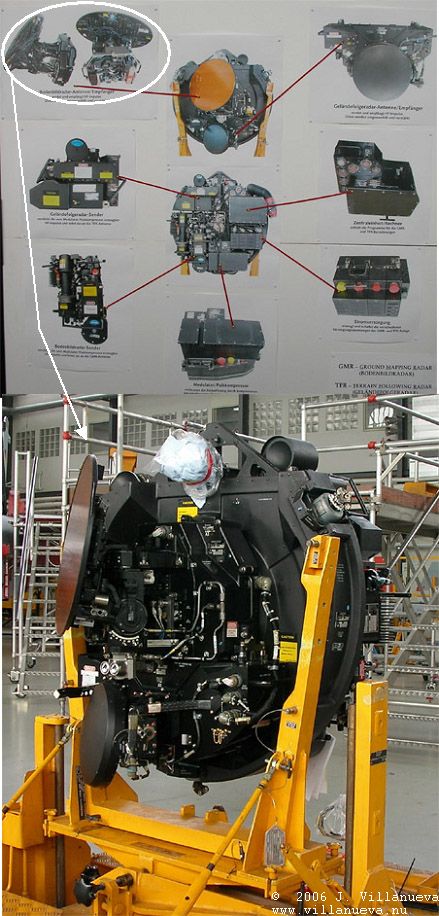
Nota: El radar que aparece en la fotografía es sólo a efectos ilustrativos, no es el ECR-90 sino su homólogo montado actualmente en el Tornado.
MIDS
MIDS es un sistema de comunicaciones, navegación e identificación con la misión de intercambiar información de vigilancia, comando y control entre distintas plataformas y sistemas de armas. Los usuarios de la red pueden intercambiarse datos sobre el estado de los sensores y del armamento, y a través del MIDS se presentan al piloto, que puede dar instrucciones a través del sistema incluso verbalmente y a otros aviones.
AESA Power Supply Controller
El CAPTOR-E sustituye la tradicional antena de plato con guiado mecánico por una antena electrónica AESA, lo que supone toda una serie de ventajas como mayor rapidez de muestreo, modos de funcionamiento simultaneo, uso de la antena para comunicaciones, etc.
Working since 1999 at INDRA SISTEMAS S.A.
in tasks related to Software engineering of airborne systems for the Eurofighter Typhoon, the European aircraft fighter.
The Typhoon is a joint venture of four nations (Germany, Spain, UK and Italy) carried out by some of the main companies of the Aerospace branch (EADS, BAE Systems, Alenia, INDRA, Selex, etc.), and also exported to Austria and Saudi Arabia.
It is a multirolle weapons system able to cope with Combat Air Patrol and Ground Attack missions. The first phase (i.e. Tranche) came into service in 2003, the second phase is already in production, and the incoming third phase is currently under development. More details in Wikipedia.
In my career I have got involved in the following projects:
- 2007 – today
Systems Engineer of the APSC (Power Supply and Controller) of the AESA (Active Electronically Scanned Array), the electronic antenna of the CAPTOR-E, where instead of a antenna plate a set of thousands of small TRMs (transmissors/emisors) are used. The CAPTOR-E is the next generation of the CAPTOR/ECR-90, with a huge improvement in its RADAR capabilities.
- 2006 – 2007
Performance analysis and optimisation of the communicatons layer of the MIU (MIDS Interface Unit). The MIDS system, or Multifunctional Information Distribution System is used to exchange tactical information (flight trayectories, targets, position, etc) among diferent combat units or military platforms in combined missions.
-
2003 – 2006
Development of the main Software elements of the diagnosis and maintenance computer MDP&PMDS, (Maintenance Data Panel & Portable Maintenance Data Store) of the UCS communications system for the Typhoon. The MDP&PMDS is used on flight to record flight data and on ground for tasks related with aircraft maintenance, including the weapon and fuel system.
-
2002 – 2003
Specification, design, implementation, testing and documentation of many software test modules for the test equipment used in the acceptance test of the Radar Scanner subsystem of the ECR90 / CAPTOR Radar Scanner.
- 1999 – 2002
Acceptance test software for the MDP&PMDS (Tranche 1), related documentation and test equipment..
Technical Notes
UCS
The UCS (Utility Control System) includes 7 computers linked together and with the aircraft via data bus MIL STD 1553B:
- 2 fuel computers
- 2 secondary power sistem (SPS) computers
- LGC, landing gear computer
- FC, front computer
- MDP&PMDS, maintenance computer
Specifically, the MDP&PMDS (Maintenance Data Panel & Portable Maintenance Data Store) is an airborne computer responsible of recording maintenance data during flight. Is localed under the left wing, and the ground crew is able to gain access to this computer using a small open and interact via its touchscreen to check its status (weapons, fuel, engines, etc).
RADAR SCANNER
The CAPTOR/ECR-90 is a multimode doppler type radar able to do multitracking, SAR, etc.
The RADAR SCANNER is one of the CAPTOR subsystems:

Remark: The radar shown in the picture is only for information, it is not the actual ECR-90 but its cousin the radar used in the Tornado.
MIDS
MIDS is a identification, communications and navigation system with the mission of allow mission data exchange (surveillance, command and control) among different platforms and weapon systems. The network users are able to share data of its sensors (ammo, fuel, and so on) and present it to the pilot, who may then instruct to the system or even to other aircrafts using voice commands.
AESA Power Supply Controller
The CAPTOR-E replaces the traditional mechanically guided plate antenna by an AESA, offering many advantages such as increased sample speed, simultaneous operation of different radar modes, communications, etc.


